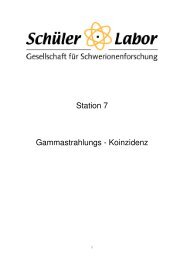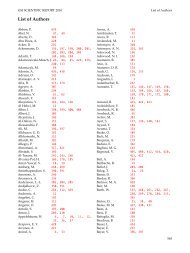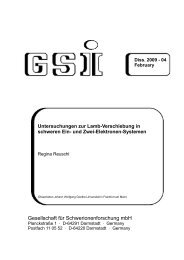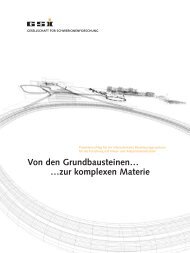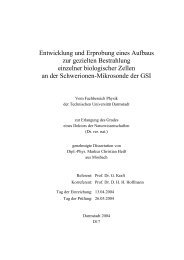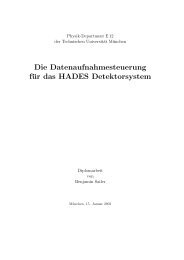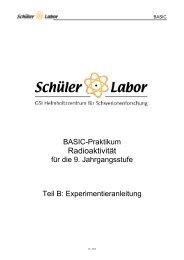CBM Progress Report 2006 - GSI
CBM Progress Report 2006 - GSI
CBM Progress Report 2006 - GSI
Create successful ePaper yourself
Turn your PDF publications into a flip-book with our unique Google optimized e-Paper software.
<strong>CBM</strong> <strong>Progress</strong> <strong>Report</strong> <strong>2006</strong> Detector Developments<br />
Electron/pion identification with fast TRD prototypes<br />
A. Andronic 1 , H. Appelshäuser 2 , V. Babkin 3 , P. Braun-Munzinger 1 , V. Cătănescu 4 , S. Chernenko 3 ,<br />
C. Garabatos 1 , S. Golovatyuk 3 , M. Hartig 2 , J. Hehner 1 , A. Herghelegiu 4 , M. Kalisky 1 , M.<br />
Klein-Bösing 5 , D. Kresan 1 , C. Lippmann 1 , D. Mi´skowiec 1 , W. Niebur 1 , D. Moisa 4 , M. Petris¸ 4 , M.<br />
Petrovici 4 , A. Radu 4 , C.J. Schmidt 1 , V. Simion 4 , R.S. Simon 1 , I. Rusanov 6 , H.K. Soltveit 6 , J.<br />
Stachel 6 , F. Uhlig 1 , J.P. Wessels 5 , A. Wilk 5 , Yu. Zanevsky 3 , and V. Zryuev 3<br />
1 <strong>GSI</strong>, Darmstadt, Germany; 2 University of Frankfurt, Germany; 3 JINR Dubna, Russia; 4 NIPNE Bucharest, Romania;<br />
5 University of Münster, Germany; 6 University of Heidelberg, Germany<br />
We report results obtained in beam tests of fast Transition<br />
Radiation Detector (TRD) prototypes. Such a TRD,<br />
envisaged for electron/pion identification, is part of the<br />
setup of the <strong>CBM</strong> detector at FAIR [1]. To cope with the<br />
envisaged rates of up to 100 kHz/cm 2 , we have chosen as<br />
detectors multi-wire proportional chambers (MWPCs) of 6<br />
mm thickness, with anode wires of 20 µm diameter with<br />
a pitch of 2 and 3 mm. Transition radiation (TR) is produced<br />
in radiators composed of polypropylene foils of 20<br />
µm thickness (d1), regularly spaced by a distance (d2) of<br />
either 200 or 500 µm, with the number of foils Nf of 220<br />
or 120, respectively. For an efficient absorption of TR, the<br />
counting gas is Xe-CO2 [85-15]. The signals are readout on<br />
pads of 8×15 mm 2 and amplified with a 16-channel ASIC<br />
preamplifier/shaper especially designed in 0.35 µm CMOS<br />
technology. The signals are sampled with a 25 MHz ADC<br />
(8 bit, nonlinear). The measurements are performed at <strong>GSI</strong><br />
with secondary beams with momenta of 1 and 1.5 GeV/c.<br />
Two segmented scintillator detectors are used for beam definition<br />
and for rate and time-of-flight measurements. Electrons<br />
are identified with respect to hadrons using a Pb-glass<br />
calorimeter and an air-filled Cherenkov detector. The beam<br />
profile is monitored using two Si-strip detectors. The MBS<br />
data acquisition system [2] is used.<br />
Average signal (mV)<br />
160<br />
140<br />
120<br />
100<br />
80<br />
60<br />
40<br />
20<br />
0<br />
electrons<br />
pions<br />
e, no TR<br />
2 mm<br />
20/500/120<br />
0 0.1 0.2 0.3 0.4 0.5 0.6 0.7 0.8 0.9 1<br />
Time (μs)<br />
Figure 1: Average signals for pions and electrons.<br />
An example of average signals is shown in Fig. 1 for<br />
the momentum of 1.5 GeV/c. The long tails are due to<br />
the slow-moving Xe ions created in the gas avalanche. The<br />
35<br />
TR, produced only by very fast particles (γ >1000), is produced<br />
at this momentum only by electrons [3] and leads to<br />
a significant increase of the signal, which is essential for<br />
improving the electron/pion separation.<br />
Yield (keV -1 )<br />
10 -1<br />
10 -2<br />
10 -3<br />
10 -4<br />
2 mm<br />
p=1.5 GeV/c<br />
Xe-CO 2 (85-15)<br />
Simulations(20/500/120)<br />
pions<br />
electrons<br />
0 5 10 15 20 25 30<br />
Energy deposit (keV)<br />
Figure 2: Measured charge spectra for pions and electrons<br />
of 1.5 GeV/c. The lines denote simulations.<br />
In Fig. 2 we show the spectra of energy deposited in<br />
our detector for pions and electrons of 1.5 GeV/c. The<br />
Landau spectrum corresponding to the ionization energy<br />
loss (dE/dx) is, in case of electrons, complemented by the<br />
TR contribution, clearly visible in the spectrum around 10<br />
keV. The absolute energy calibration has been done using<br />
the pion spectra with respect to simulations [4], shown in<br />
Fig. 2. These simulations reproduce very well the spectral<br />
shape for pions, but are describing the TR part only approximately.<br />
The measured TR appears to be softer than in the<br />
simulations.<br />
The spectra measured with one layer (Fig. 2) allow us to<br />
simulate the electron identification capability of a TRD as<br />
a function of the number of layers. The results are shown<br />
in Fig. 3 for two momenta and for two radiators (characterized<br />
by d1/d2/Nf ). An improvement in the e/π separation<br />
is seen at 1.5 GeV/c compared to 1 GeV/c due to the strong<br />
increase of the TR yield for electrons [3], which overcomes<br />
the relativistic rise of dE/dx of pions [4]. For higher mo-



